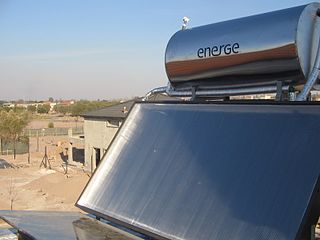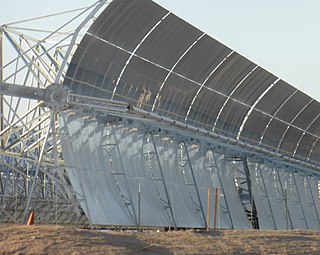
Solar thermal energy (STE) is a form of energy and a technology for harnessing solar energy to generate thermal energy for use in industry, and in the residential and commercial sectors.

The SOLAR Project consists of the Solar One, Solar Two and Solar Tres solar thermal power plants based in the Mojave Desert, United States and Andalucía, Spain. The US Department of Energy (DOE) and a consortium of US utilities built the country's first two large-scale, demonstration solar power towers in the desert near Barstow, California.

Nevada Solar One is a concentrated solar power plant, with a nominal capacity of 64 MW and maximum steam turbine power output up to 72 MW net (75 MW gross), spread over an area of 400 acres (160 ha). The projected CO2 emissions avoided is equivalent to taking approximately 20,000 cars off the road. The project required an investment of $266 million USD, and the project officially went into operation in June 2007. Electricity production is estimated to be 134 GWh (gigawatt hours) per year.

Gemasolar is a concentrated solar power plant with a molten salt heat storage system. It is located within the city limits of Fuentes de Andalucía in the province of Seville, Spain.

There are several solar power plants in the Mojave Desert which supply power to the electricity grid. Insolation in the Mojave Desert is among the best available in the United States, and some significant population centers are located in the area. These plants can generally be built in a few years because solar plants are built almost entirely with modular, readily available materials. Solar Energy Generating Systems (SEGS) is the name given to nine solar power plants in the Mojave Desert which were built in the 1980s, the first commercial solar plant. These plants have a combined capacity of 354 megawatts (MW) which made them the largest solar power installation in the world, until Ivanpah Solar Power Facility was finished in 2014.

Concentrated solar power systems generate solar power by using mirrors or lenses to concentrate a large area of sunlight onto a receiver. Electricity is generated when the concentrated light is converted to heat, which drives a heat engine connected to an electrical power generator or powers a thermochemical reaction.

BrightSource Energy, Inc. is an Oakland, California based, corporation that designs, builds, finances, and operates utility-scale solar power plants.

A solar power tower, also known as 'central tower' power plant or 'heliostat' power plant, is a type of solar furnace using a tower to receive focused sunlight. It uses an array of flat, movable mirrors to focus the sun's rays upon a collector tower. Concentrating Solar Power (CSP) systems are seen as one viable solution for renewable, pollution-free energy.
SolarReserve was a developer of utility-scale solar power projects which include Concentrated Solar Power (CSP) and Photovoltaic (PV) technology. The company has commercialized solar thermal energy storage technology that enables solar power tower CSP plants to deliver electricity day and night. In this technology, a molten salt is used to capture the energy from the sun and store it. When electricity is needed, the stored liquid salt is used to turn water into steam to turn a turbine and generate electricity.

eSolar is a privately held company that develops concentrating solar power (CSP) plant technology. The company was founded by the Pasadena-based business incubator Idealab in 2007 as a developer of CSP plant technology. The company aims to develop a low cost alternative to fossil fuels through a combination of small heliostats, modular architecture, and a high-precision sun-tracking system. In October 2017, an article in GreenTech Media suggested that eSolar ceased business in late 2016.

Solar power in California includes utility-scale solar power plants as well as local distributed generation, mostly from rooftop photovoltaics. It has been growing rapidly because of high insolation, community support, declining solar costs, and a Renewable Portfolio Standard which requires that 33% of California's electricity come from renewable resources by 2020, and 60% by 2030. Much of this is expected to come from solar power via photovoltaic facilities or concentrated solar power facilities.

The Ivanpah Solar Electric Generating System is a concentrated solar thermal plant in the Mojave Desert. It is located at the base of Clark Mountain in California, across the state line from Primm, Nevada. The plant has a gross capacity of 392 megawatts (MW). It deploys 173,500 heliostats, each with two mirrors focusing solar energy on boilers located on three 459 ft tall solar power towers. The first unit of the system was connected to the electrical grid in September 2013 for an initial synchronisation test. The facility formally opened on February 13, 2014. In 2014, it was the world's largest solar thermal power station.

Sierra SunTower was a 5 MW commercial concentrating solar power (CSP) plant built and operated by eSolar. The plant is located in Lancaster, California. As of mid-August, 2018, the two towers that were the center of the facility are no longer standing. The plant, however, is still present.

The Crescent Dunes Solar Energy Project is a solar thermal power project with an installed capacity of 110 megawatt (MW) and 1.1 gigawatt-hours of energy storage located near Tonopah, about 190 miles (310 km) northwest of Las Vegas. Crescent Dunes is the first commercial concentrated solar power (CSP) plant with a central receiver tower and advanced molten salt energy storage technology, following the experimental Solar Two.

The Mojave Solar Project (MSP) is a concentrated solar power (CSP) facility in the Mojave Desert in California, about 20 miles (32 km) northwest of Barstow. Surrounding the hamlet of Lockhart, Mojave Solar is adjacent to Harper Lake and the SEGS VIII–IX solar plant.
The McCoy Solar Energy Project is a 250 megawatt (MWAC) photovoltaic power plant near the city of Blythe in Riverside County, California. It occupies about 2,300 acres of mostly public land in the Mojave Desert. The construction uses CdTe thin film panels from First Solar, and the output is being sold to Southern California Edison under a power purchase agreement.

The Genesis Solar Energy Project is a concentrated solar power station located in the Mojave Desert on 1,920 acres (780 ha) of Bureau of Land Management land, in eastern Riverside County, California. The plant is owned/managed by Genesis Solar, LLC, a subsidiary of NextEra Energy Resources, LLC. The Genesis Solar Energy Project is located about 25 miles (40 km) west of Blythe, in the Lower Colorado River Valley. The plant was built in the Colorado Desert along an ancient trade route that native people had traveled for thousands of years. The route traversed the Sonoran Desert and enabled trade between the Colorado River and the coast.
The Copiapó Solar Project is a 390 megawatt (MW) net solar thermal power project to be located near Copiapó, about 65 kilometers east of the coastal town of Caldera. The project is being developed by SolarReserve, and is scheduled to reach commercial operation in 2019.
The Sandstone Solar Energy Project was an up to 1,600 megawatt (MW) solar thermal power project with 16 gigawatt-hours of energy storage, planned just to the east of Tonopah, about 170 miles (270 km) northwest of Las Vegas. The project was about up to eight 200 MW solar towers with integrated molten salt energy storage technology. The project, developed by SolarReserve and owned by Sandstone Solar Energy, LLC. was anticipated to cost about $5 billion. Planned energy output is 5,600 GW·h per year.












